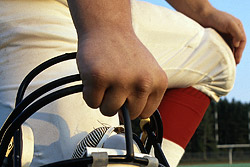Injuries are a fact of life for football players. A torn knee ligament, ruptured Achilles tendon or a serious concussion can end a season or even a player’s career. New research from sports medicine specialists at Washington University School of Medicine in St. Louis shows arm injuries are also causing NFL players to miss significant game and practice time.

The researchers reviewed National Football League injury records over 10 seasons to get an idea of how often finger, hand, wrist, elbow and arm injuries occurred, what caused those injuries and whether some might be preventable. They found 2,224 of them catalogued in the league’s injury surveillance database and published their findings in the American Journal of Sports Medicine. Knowing which positions are at risk for particular injuries and what those players were doing when they got hurt may help prevent some of those injuries in the future.
“Players with finger and hand injuries are treated by medical personnel each week, and most people won’t even know that player is injured,” says Matthew J. Matava, M.D., a sports medicine specialist at Washington University School of Medicine and team physician for the St. Louis Rams. “Whether he can continue to play will depend upon his position. Obviously, it’s a lot easier for a lineman to play in a cast than it is for a quarterback, running back or wide receiver.”
It turns out that offensive and defensive linemen are the most likely positions to sustain hand injuries. Some 80 percent of hand injuries involve broken fingers. Defensive backs are the most likely to suffer a sprained or broken thumb. Jammed and dislocated fingers usually affect receivers and defensive backs.
“There’s not much we can do to prevent most finger and hand injuries,” says Matava, who is an associate professor of orthopedics. “You can protect the head with a helmet and put pads on the shoulders, but most players need their fingers and hands free to be at their best. Luckily, not many of these athletes lose much game time as a result of these injuries.”
The same cannot be said for the wrist, forearm and elbow. Players with those injuries often miss significant amounts of time. Elbow injuries averaged 22 days lost, wrists 27 days, and forearms 42 days. That’s almost half the NFL season.
The majority of these injuries occurred among offensive and defensive linemen, and 75 percent were elbow injuries. Defensive backs had twice as many forearm injuries as players at any other position.
For all of the injuries that Matava’s research team analyzed, the most dangerous football activity was tackling. Tackling was involved 28 percent of the time when hand, finger and thumb injuries occurred and 24 percent of the time in wrist, forearm and elbow injuries.
“Obviously, you can’t avoid tackling in football,” Matava says. “You can make rules to eliminate blocking from behind or spearing or other dangerous things, but you can’t eliminate tackling without fundamentally changing the game.”
Matava says it may be possible to protect players from some of these injuries by having them wear protective braces. At the collegiate level, for example, many linemen wear knee braces to protect against knee injuries, but the NFL does not require elbow or wrist braces. Matava believes if such requirements were proposed, players might object.
“When you start putting braces on players — or any equipment for that matter — they tend to complain that it impairs their mobility,” he says. “Receivers say thigh pads slow them down. If there were strong evidence that braces would prevent elbow injuries in the same way that helmets can limit concussion risk, then the league might consider requiring that equipment, but we’re not at that point.”
Matava says in addition to cataloguing the types of injuries that affect NFL players, looking through the league’s injury database also may be an important way to learn to prevent similar injuries in younger college and high school players. Most previous research has simply studied football injuries in general, rather than specifically looking at positions, types of injuries and how they occurred.
“We hope this type of survey will become the ‘gold standard’ of injury research in football and that it, perhaps, will trickle down to the NCAA level and the high school level,” Matava says. “But we have to be careful we don’t try to take too much information from these studies and apply it to younger kids. An NFL player has very different risks than a 15-year-old playing football, just in terms of the size of the other players and the speed of the game. Plus, there are different risks involved when talking about immature growth plates or developing muscles and bones when compared to full-grown, highly conditioned athletes.”
Mall NA, Carlisle JC, Matava MJ, Goldfarb CA. Upper extremity injuries in the National Football League, Part I: Hand and digital injuries. American Journal of Sports Medicine, June 2008 doi:10.1177/0363546508318197
Carlisle JC, Goldfarb CA Mall NA, Matava MJ. Upper extremity injuries in the National Football League, Part II: Elbow, forearm and wrist injuries. American Journal of Sports Medicine, July 2008 doi:10.1177/0363546508318198
Washington University School of Medicine’s 2,100 employed and volunteer faculty physicians also are the medical staff of Barnes-Jewish and St. Louis Children’s hospitals. The School of Medicine is one of the leading medical research, teaching and patient care institutions in the nation, currently ranked third in the nation by U.S. News & World Report. Through its affiliations with Barnes-Jewish and St. Louis Children’s hospitals, the School of Medicine is linked to BJC HealthCare.